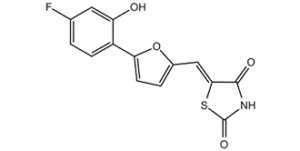AS-252424
This product is for research use only, not for human use. We do not sell to patients.

For small sizes, please check our retail website as below: www.invivochem.com
| Size | Price | Stock |
|---|---|---|
| 250mg | $900 | Check With Us |
| 500mg | $1420 | Check With Us |
| 1g | $2130 | Check With Us |
Cat #: V0130 CAS #: 900515-16-4 Purity ≥ 98%
Description: AS-252424 is a novel, potent, orally bioactive and selective PI3Kγ inhibitor with potential anticancer activity.
Top Publications Citing Invivochem Products
Publications Citing InvivoChem Products
Product Promise

- Physicochemical and Storage Information
- Protocol
- Related Biological Data
- Stock Solution Preparation
- Quality Control Documentation
| Molecular Weight (MW) | 305.28 |
|---|---|
| Molecular Formula | C14H8FNO4S |
| CAS No. | 900515-16-4 |
| Storage | -20℃ for 3 years in powder formr |
| -80℃ for 2 years in solvent | |
| Solubility In Vitro | DMSO: 61 mg/mL (199.81 mM)r |
| Water:<1 mg/mLr | |
| Ethanol: <1 mg/mL | |
| Solubility In Vivo | 4% DMSO+50% PEG 300+5% Tween 80+ddH2O: 5mg/mL |
| SMILES Code | O=C(NC/1=O)SC1=C/C2=CC=C(C3=CC=C(F)C=C3O)O2 |
| Synonyms | AS252424; AS 252424; AS-252424 |
| Protocol | In Vitro | AS-252424 also inhibits PI3Kα, PI3Kβ and PI3Kδ with IC50s of 935±150 nM, 20 μM and 20 μM, respectively. AS-252424 inhibits MCP-1-mediated chemotaxis in wild-type primary monocytes in a concentration-dependent manner with an IC50 value of 52 μM, as well as in the monocytic cell line THP-1 with an IC50 value of 53 μM. In the human monocytic cell line THP-1, MCP-1 binding to the GPCR chemokine receptor CCR2, strongly induces phosphorylation of PKB/Akt, which is effectively inhibited by AS-252424 at IC50 values as low as 0.4 μM. In contrast, induction of PKB/Akt phosphorylation by colony stimulating factor (CSF-1), binding to the growth factor receptor c-fms, is only blocked by AS-252424 at IC50 values as high as 4.7 μM. |
|---|---|---|
| In Vivo | Oral administration of AS-252424 in a mouse model of acute peritonitis leads to a significant reduction of leukocyte recruitment. To evaluate the efficacy of AS-252424 to block leukocyte migration in vivo, it is tested in a mouse model of thioglycollate-induced peritonitis. Oral administration of AS-252424 at 10 mg/kg results in moderate reduction of neutrophil recruitment (35%±14%), almost matching the result observed in PI3Kγ-deficient mice. Given the short oral half-life of AS-252424 (t1/2=1 h) and relative high clearance (2.25 L/kg per h), investigations at later time points (24-48 h) to assess macrophage and monoycyte recruitment are not undertaken. The modest pharmacokinetic properties do not appear to be caused by rapid oxidative metabolism (microsomal metabolism after 1 h: 16% (rat), 10% (human)). |
These protocols are for reference only. InvivoChem does not
independently validate these methods.
| Solvent volume to be added | Mass (the weight of a compound) | |||
|---|---|---|---|---|
| Mother liquor concentration | 1mg | 5mg | 10mg | 20mg |
| 1mM | 3.2757 mL | 16.3784 mL | 32.7568 mL | 65.5136 mL |
| 5mM | 0.6551 mL | 3.2757 mL | 6.5514 mL | 13.1027 mL |
| 10mM | 0.3276 mL | 1.6378 mL | 3.2757 mL | 6.5514 mL |
| 20mM | 0.1638 mL | 0.8189 mL | 1.6378 mL | 3.2757 mL |
The molarity calculator equation
Mass(g) = Concentration(mol/L) × Volume(L) × Molecular Weight(g/mol)
Mass
=
Concentration
×
Volume
×
Molecular Weight*
The dilution calculator equation
Concentration(start)
×
Volume(start)
=
Concentration(final)
×
Volume(final)
This equation is commonly abbreviated as: C1 V1 = C2 V2
Concentration(start)
C1
×
Volume(start)
V1
=
Concentration(final)
C2
×
Volume(final)
V2
Step One: Enter information below
Dosage mg/kg
Average weight of animals g
Dosing volume per animal µL
Number of animals
Step Two: Enter the in vivo formulation
%DMSO
+
%
+
%Tween 80
+
%ddH2O
Calculation Results:
Working concentration:
mg/ml;
Method for preparing DMSO master liquid:
mg
drug pre-dissolved in
µL
DMSO(Master liquid concentration
mg/mL)
,Please contact us first if the concentration exceeds the DMSO solubility of the batch of drug.
Method for preparing in vivo formulation:
Take
µL
DMSO master liquid, next add
µL
PEG300, mix and clarify, next add
µL
Tween 80,mix and clarify, next add
µL
ddH2O,mix and clarify.
Note:
- (1) Please be sure that the solution is clear before the addition of next solvent. Dissolution methods like vortex, ultrasound or warming and heat may be used to aid dissolving.
- (2) Be sure to add the solvent(s) in order.




































